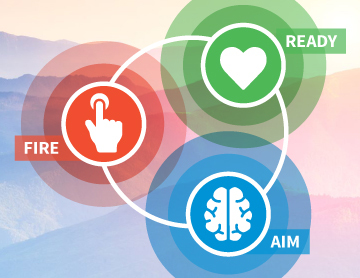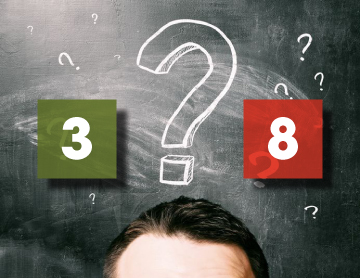There are different opinions regarding the centers and the way in which they relate to the nine Enneagram points. We would like to explore the centers through the lens of the fractal pattern that is structurally embedded in the Enneagram. We have observed three different yet equally valid ways of working with and interpreting the centers.
The language around the three centers differ from one author or school to the next. For the purposes of this article, we will mostly refer to the three centers as the action, feeling and thinking centers for ease of reference, but the centers are also known as follows:
- Action Center: Instinctive, body, gut or belly center
- Feeling Center: Heart center
- Thinking Center: Head center
Perspective 1: Intrapersonal Center
Centers of StructureThis is the most frequently utilised way of looking at the centers and holds that Enneagram types 8, 9 and 1 relate to the action center, Enneagram types 2, 3 and 4 relate to the feeling center and Enneagram types 5, 6 and 7 relate to the thinking center. The position of the types in relation to the centers is not an arbitrary one, as each of the nine types have some issues or challenges to resolve in relation to their center and the emotional theme associated with that center. The action center is associated with emotional challenges relating to anger, the feeling center is linked to shame and the thinking center to anxiety.
Within this perspective, there is also a pattern that repeats in so far as the center contains one of the following three patterns of the expression of the energy of the center:
- Introjected or internalised
- Confused
- Externalised or projected
From this perspective the centers offer us a pathway for exploring how a particular emotional theme plays out in our lives. This perspective is the intrapersonal perspective. It relates to how our center’s emotional theme is constructed within us. It has a clear and direct relationship with the psychodynamics of a person’s Enneagram type. This may or may not be visible to others around us, although the likelihood of others being aware of this intrapersonal process will increase for the externalised or projected type within each of the centers.
This perspective is a static or structural perspective. The Enneagram point of resonance of the individual will determine the center into which they fall (and vice versa). In other words, all people who resonate with Enneagram 8 will fall into the action center and will need to work through the issues they have regarding externalising or projecting anger in the same way that all people who resonate with Enneagram 5 will need to work through the issues they have regarding the introjection or internalisation of anxiety. The structure of the Enneagram determines the correspondence between type and the intrapersonal expression of the center.
Perspective 2: Interpersonal Center
Centers of Expression The second perspective relates to the external world and how others perceive my participation in the world. This perspective of the centers is more behavioural in nature and is determined by how I interact with others. Clearly we all have the ability to act, feel and think. However, the energy and nature of my interaction with others may lead to people experiencing me as more of a thinker, more emotional or more of a doer.This interpersonal expression of the center is not necessarily linked to Enneagram type. This opens the possibility that some individuals who resonate with Enneagram 1, for example, may be expressing themselves as “thinkers” in the world, whereas another may be more emotional or more action-oriented, regardless of the fact that Enneagram 1 has a structural or intrapersonal position on the Enneagram in the action center. The interpersonal center expression can lead to mistyping of self or mistyping by others if one confuses the interpersonal expression with the intrapersonal expression of the center.
“It has, I think, long been debunked that just because a person’s ennea-type is formed from a particular Center that that is the primary Center they use. For example, many 9s are not so much in touch with their body center; many 9s relate more to the heart center and some to the head center. Many 3s do not relate to being heart-centered and some don’t appear this way either.”
-Ginger Lapid-Bogda
Source: Why we need Claudio Naranjo
From a growth and development perspective, the center that we are most likely to show others through our interactions, is often out of balance or unhealthy in its expression in relation to the other centers. A highly emotionally expressive individual is more likely to make some decisions without due consideration for facts and objective analysis and may override or ignore signals from the body or gut that their course of action is potentially problematic. Likewise an individual who is highly action oriented in their expression in the world may not pay sufficient attention to careful planning or the impact of their decisions on others and may rush into the premature implementation of impulsive decisions. An individual who is highly thinking oriented may fall into “analysis paralysis” and struggle to move to action or may engage in a cold and emotionless way with others.
As the interpersonal center expression drives behaviour, others are able to give us valuable feedback with regards to how they perceive us. This use of the center is not directly correlated to the invisible intentions and the psychodynamics of type (although these patterns still influence behaviour), but rather by how we behave in the world.
Perspective 3: Transformational Center
Centers of Intelligence This perspective is beautifully positioned by Roxanne Howe-Murphy (2013) as the practice of presence which enables us to access each of the centers as a center of intelligence . A center’s expression becomes intelligent when we are able to be present to it in a grounded, open-hearted and clear way. This kind of presence is not necessarily a pleasant, ephemeral and disconnected or trance-like state, as Howe-Murphy notes there are many misconceptions regarding what it means to be present.Each of the centers offer us a point of contact through our sensations which enables us to be present. This requires a deepening of our relationship with all three of our centers of intelligence. This deepening can be seen as analogous to the levels of development within each Enneagram type. As we become present to the intelligence of a center, we integrate and express ourselves at a higher level of development. At this higher level the center is transformed from the expression of action, feeling and thinking to a higher-order of body, heart and head centered intelligence.
Howe-Murphy positions the intelligence offered by each center as follows:
- Body center: Grounded and alive
- Heart center: Receptive, open-hearted and authentic
- Head center: Quiet, spacious and trusting
A particular pattern that is useful to focus on relates to bringing balance across the centers. For example, an individual who is dominant in the expression of their feeling center at an interpersonal level is likely to benefit greatly by developing their body and head centered intelligence in order to transform the expression of the heart center. These intelligences also build on each other: presence of body opens the door to presence of heart which in turn opens the door to presence of mind.
The centers, like so many fractal patterns contained within the Enneagram, offer multiple perspectives and also contain multiple constructs or interpretations of a central construct.The way in which we have been working with the centers as a broader Enneagram community has created confusion. To date the language and construct boundaries we have used to denote each of the three perspectives described in this article have been blurred and unclear, which has created the impression of competing rather than complementary interpretations of the centers.
This article attempts to bring the boundaries and perspectives into crisp focus to enable us to have a more useful conversation and application of the central construct of the centers in future.
REFERENCES:
-
Howe-Murphy, R. 2013. Deep Living: Transforming Your Relationship to Everything that Matters through the Enneagram . Santa Fe: Enneagram Press
-
Lapid-Bogda, G. 2011. Why we need Claudio Naranjo More Than Ever. Published online October 24, 2011

 What is the Enneagram?
What is the Enneagram?
 Introduction to the 27 Subtypes
Introduction to the 27 Subtypes
 Enneagram History & Origin
Enneagram History & Origin
 Introduction to the 3 Centers
Introduction to the 3 Centers
 Wings
Wings
 Lines and Integration
Lines and Integration
 Enneagram for Myself
Enneagram for Myself
 Enneagram for Practitioners
Enneagram for Practitioners
 Enneagram for Business
Enneagram for Business
 iEQ9 Individual Reports
iEQ9 Individual Reports
 iEQ9 Team Reports
iEQ9 Team Reports
 iEQ9 Questionnaire
iEQ9 Questionnaire
 Training Events
Training Events
 Level 1 iEQ9 Accreditation
Level 1 iEQ9 Accreditation
 Level 2 Enneagram Team Dynamics
Level 2 Enneagram Team Dynamics
 International Enneagram Conference
International Enneagram Conference
 iEQ9 Community of Practice Events
iEQ9 Community of Practice Events
 About Integrative9
About Integrative9
 Meet the Faculty
Meet the Faculty
 Testimonials
Testimonials
 Contact Us
Contact Us




